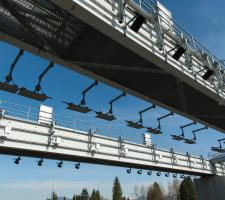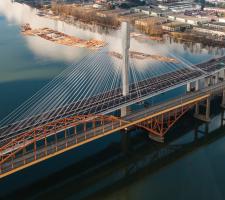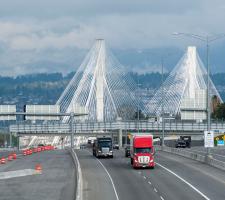
The Port Mann Bridge in Vancouver is a prime example of how the latest ITS systems enable new infrastructures to be built and paid for while still providing additional user benefits.
Vancouver has 2.2 million inhabitants and, like so many major cities, is divided into two by a river, the Frazer river. This combination makes Vancouver the second most congested city in North America and the most congested in Canada. Through the middle of the city runs the Trans-Canadian Highway 1 which crosses the Frazer River at the old toll-free Port Mann Bridge while further upstream is the tolled Golden Ears Bridge. The original five lane Port Mann Bridge was built in the early 1960s when the population was only 800,000 but struggles to cope with modern day volumes which can reach between 100,000 and 125,000 vehicles per day. As a result, the old bridge could be congested for up to 14 hours per day.So a new 10-lane cable-stay Port Mann bridge with four general and one high occupancy lane in each direction has been constructed. It is the largest and longest main span river crossing in Western Canada; the second longest in North America and in the top 30 worldwide. The bridge deck is 42m above the high water mark and at 65m wide is claimed to be the widest in the world. It has 50m of roadway (including shoulders) and a 5m wide multi-use path, with 3m of clearance for pedestrians and cyclists. It has been designed to not only cope with the current traffic volumes, but also the anticipated increase in traffic over the next 20 to 30 years.
Such major projects come with equally large price tags and initially funding was to come from a PPP financing deal. However this failed to materialise so in 2009 a public crown corporation, known as the Transportation Investment Corporation (TI Corp), was set up under the Transportation Investment Act. The Company’s remit was to build, operate and maintain a new Port Mann Bridge along with improvements to 37km of TransCanada Highway through Metro Vancouver. TI Corp is also charged with the development, implementation and management of tolling operations to pay for the project.
Subsequently TI Corp appointed the Kiewit-Flatiron General Partnership as the design-build constructor and
CS ITS (now Sanef ITS) supplied, installed, tested and commissioned the hardware and systems for toll processing as well as setting up accounts. It also remains responsible for the maintenance of the tolling equipment and of the back-office system.
Trans-Canada Flow Tolling, a consortium of
The tolling infrastructure consists of two gantries on either carriageway that carry the free flow tolling and traffic management systems equipment. Both gantries are fitted with 10 cameras and three laser scanners while the second also has four antennas. The cameras are triggered by loops and photograph both the front and rear number plates, and the system is able to track and capture vehicle switching lanes between the first and second gantries.
The primary tolling system, which has been given the brand name TReO, has been developed by Sanef ITS for TI Corp. This system provides fully electronic open road tolling using ISO 18000-6C windscreen decals which are read by gantry-mounted lasers while cameras capture licence plate details as well as measuring the vehicle’s dimensions for categorisation purposes.
In addition to TReO RFID tags, the tolling infrastructure is interoperable with a number of RFID systems including Title 21 transponders and ASTM V6 tags. This is backed up with ANPR cameras for non-registered users and enforcement purposes. The system processes the collected data and automatically generates invoices and statements (for a more detailed description of the tolling system see
For tolling purposes vehicles are categorised into motorcycles (CAD$1.50 per trip), cars (CAD$3.00), medium vehicles such as car and caravan, light truck or motorhome (CAD$6.00) and heavy truck (CAD$9.00). Registered drivers can pay electronically while occasional users can pay by phone or mail, online, through their bank or at one of two customer service centres.
The bridge opened for traffic on 1 December 2012, initially with four lanes in either direction until such time that the original bridge is closed. Initial findings are that travel times have been reduced by up to 50%, easily exceeding the 30% to 40% target. For the first week the bridge was toll-free and this was followed by a 50% discount for three months; or until December 2013 for registered users. After that period expires the full toll will be levied.
Having seen the travel time benefits the bridge offers, by the time tolls were levied 70% of the users were registered for electronic payment. Over the first six months of operation this figure has risen close to 80% and has already met TI Corp’s 2013/14 financial year prediction. Temporary users can get a monthly pass with a limited number of trips. Non-registered and occasional users must pay within seven days otherwise they will be notified by mail and will incur an additional CAD$2.30 licence plate processing fee for each trip.
There is potential for lost revenue either because vehicles are not detected or identified, or because for some reason toll cannot be collected from the owners of certain identified vehicles (out of state, foreign registration etc). Trans-Canada Flow Tolling is contracted to provide a service to collect tolls for vehicles using the bridge and their owners. While not being specific to this contract Eric Wurmser, development director for electronic tolling for Egis Projects, says typical across-the-board performance levels are around 99.5% for detection of vehicles and 98.5% for identification. He adds that identification performance can be affected by factors such as rain, fog, ice and snow and manual examination of CCTV images and ANPR data is required to identify some of the vehicles that do not have tags.
All toll fees are paid directly to TI Corp and, given that the agreed service performance targets are met, it pays Trans-Canada Flow Tolling as a service provider. The actual cost of collecting the fee is not detailed separately in TI Corp’s figures although its 2013/14 – 2015/16 service plan puts highways and maintenance costs, which includes paying third party contractors, at CAD$9 million or CAD$10 million.
According to Wurmser the cost of collecting tolls for a service provider varies from one contract to another depending on many factors. These include how the tolling is done and the enforcement rules specified as well as factors such as which party pays bank charges when drivers use credit cards.
By the time construction is complete in 2014/15, the project will include 37km of highway widening - two additional lanes in each direction to the east of the bridge and one lane in each direction on the west. To accommodate these changes nine interchanges on Highway 1 will be replaced and seven overpasses have to be widened while 15 new overpasses and underpasses will be built or rebuilt.
When the project is completed, travel times on short journeys across the Frazer are expected be reduced by up to two thirds in comparison to those on the previous, toll-free bridge. These time savings are expected to increase over the years as the general rise in traffic volume exacerbates congestion on alternative routes.
Finance
Under its agreement, by 2050 TI Corp must not only repay the cost of building the bridge but also the other upgrades on Highway 1 detailed above. In its 2013/14 – 2015/16 Service Plan, TI Corp puts the target revenue for 2013/14 at CAD$121m and this rises to CAD$202 by the end of the period. In 2013/14 as revenue builds and major expenditure starts to diminish, the company expects to start posting operating profits. However, TI Corp expects interest charges will see net debt continue to increase through to 2014/15 from which point they will start declining although the retained loss will continue to rise in 2015/16.
Two major risk mitigations were put in place: one that requires the construction contractor to meet specific deadlines and the second is a long-term hedging strategy to mitigate the risk of interest rate fluctuations. In an effort to retain the travel time advantage and thereby deter drivers from using other routes, the company has implemented an incident management procedure and weather monitoring, and has pledged to continue investment in the bridge and the highway.














